In 2014, Formula 1 switched away from V8 engines, electing instead to mandate all teams race with turbocharged V6 engines of 1.6 litres displacement, fitted with advanced energy recovery systems. The aim was to return Formula 1 to having some vague notion of relevance to modern road car technologies, with a strong focus on efficiency. This was achieved by mandating maximum fuel consumption for races, as well as placing a heavy emphasis on hybrid technology.
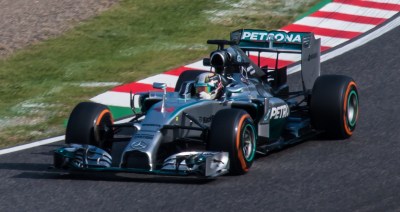
Since then, Mercedes have dominated the field in what is now known as the turbo-hybrid era. The German team has taken home every drivers and constructors championship since, often taking home the crown well before the season is over. Much has been made of the team’s engine as a key part of this dominance, widely considered to be more powerful and efficient than the competition at all but a few select races in the last seven years, and much of the credit goes to the company’s innovative split-turbo system. Today, we’ll explore why the innovation was such a game changer in Formula 1.
Many and Varied Gains
This article assumes a basic working knowledge of turbochargers. If you’re not quite up to speed yet, check out our primer on the topic!
The basic template given to the teams was to produce 1.6 litre engines with forced induction, with the option of using a turbocharger or supercharger, with all teams electing to use turbos in their designs. Additionally, teams were able to use energy recovery systems to further boost performance and efficiency. The MGU-K, standing for Motor Generator Unit – Kinetic, is connected to the engine’s crankshaft, harvesting energy under braking and supplying power during acceleration. The MGU-H, or Motor Generator Unit – Heat, is connected to the turbocharger’s shaft, and can thus turn waste energy from the exhaust into electricity, or conversely, spin up the turbocharger to reduce turbo lag.
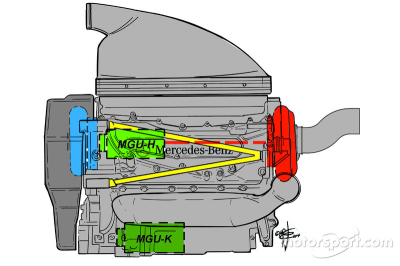
Most manufacturers went with tightly-packaged designs featuring relatively conventional turbos, albeit with a MGU-H unit attached for energy recovery. However, Mercedes decided to aim for an unconventional split-turbo design. In a regular turbocharger, the compressor wheel and turbine wheel are connected by a short shaft, with the respective housings mounted directly back to back. However, Mercedes realised there were a multitude of gains to be had by instead splitting the two halves further apart. Instead, the compressor was mounted at the front of the engine, and the turbine at the rear. The two were joined with a much longer shaft than is usual, passing through the vee of the engine. This also allowed the MGU-H to be mounted in the center of the vee, between the compressor and turbine.
The design promised a multitude of benefits. Separating the turbine from the compressor meant that heat from the exhaust gases wouldn’t bleed into the compressor as much, reducing intake temperatures and allowing the team to fit a smaller intercooler. The packaging benefits also allowed the team to make the whole engine, or power unit, more compact, giving the chassis designers more freedom to make aerodynamic optimisations to the car. It also allowed for cleaner, more straightforward routing of the exhaust piping, which helps with power output, and shorter intake piping, which helps reduce lag for better driveability.
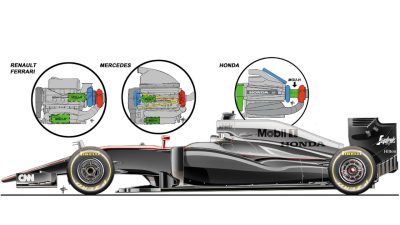
With all the benefits to be had, it raises the question why the solution was such a novel one, and the reason is speed. The turbochargers in an F1 car spin at over 100,000 RPM. At such high rates of angular velocity, the slightest imbalance in a shaft can destroy a turbo in seconds. Making that shaft almost an order of magnitude longer only makes things worse, due to the greater moment arm created by the length exacerbating even the smallest vibrations significantly. However, top tier motorsport is the right venue for attempting new feats in materials and machining, and Mercedes were able to make the system work. The team leaned on their institutional experience with turbocharging in the Daimler truck division, with work on the engine beginning as far back as 2011 to prepare for the initial 2014 season. After their dominating performance in the first three years of the turbo-hybrid era, Honda elected to copy the idea for their 2017 engine. More recently, Renault have been linked with a switch to the layout, with Ferrari rumoured to be considering the concept too.
Not Destined for the Open Road
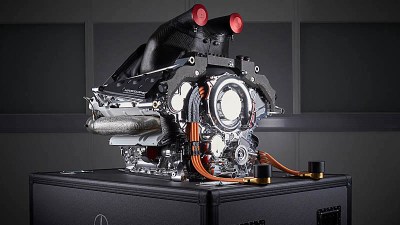
Despite Formula 1’s renewed focus on technologies that are transferable to the road, it’s not likely that you’ll see split turbos nestled in the vee of your performance road car any time soon. Formula 1 is a world where incremental percentage gains can make or break a World Championship effort, and where every last scrap of aerodynamic downforce is necessary to come out on top of the competition. Road cars simply don’t have any real reason to focus on such tight packaging, or minor gains in cooler inlet temperatures from such technology. It’s generally far simpler to bolt on a larger intercooler and make the bonnet a little longer instead. Additionally, the tight machining tolerances required for such a long, high-speed shaft would make such turbos prohibitively expensive for any road car. They’d also likely have maintenance intervals entirely unsuitable outside of the racing environment.
While split-turbo technology remains limited to on-track action in F1, it nonetheless shows how thinking outside the box and ignoring convention can lead to real world engineering benefits. While its competitors play catch up, we’re sure Mercedes F1 engineers are already looking around the corner for the next nifty idea that will end up worth a second a lap on the circuit.

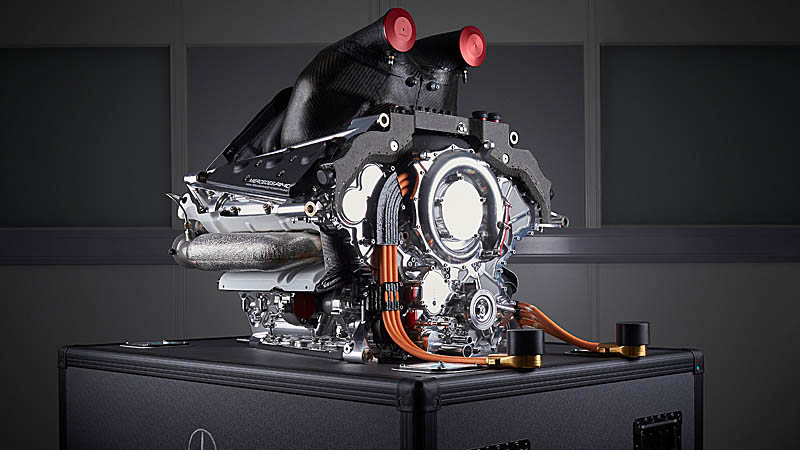













…and F1 has never been more boring!
It became unwatchable. Switched to formula offroad, which still has pleasant engine scream.
Formula… OFFROAD?
Where can I learn this power
First race of the year wasn’t! But I agree the cars don’t sound as good as they used to.
I don’t really follow Formula racing, but from what little I have seen, the F1 cars may sound better than the Formula E cars.
If all you want is high pitched screaming and whining, I have a Celine Dion CD you can borrow…
Borrow would imply you want it back?!
If you just ignore the silver arrows, and watch the mid field pack (haas, renault, mclaren) it does tend to be more exciting. Maybe haas will only have 1 car finishing, maybe ferrari will be a mid field contender, maybe Alpine will build a car that will finish a race.
With any luck, we may have the Red Bulls disrupting the front too.
Will Mazepin finish a lap? Will he take out a back marker? Will he take out a front runner? How many times will he spin? Tune in to the next Wheel of Fortune to find out!
“This was achieved by mandating maximum fuel consumption for races” ????
Probably the antithesis of what F1 is trying to achieve.
Poor wording. “by mandating a maximum fuel consumption for races that cannot be exceeded without penalty”, would have removed the ambiguity.
Even better: …by limiting maximum fuel consumption…
“The aim was to return Formula 1 to having some vague notion of relevance to modern road car technologies, with a strong focus on efficiency.”
Which was really a bad joke and done to see if the people who keep pushing for F1 to be more efficient because of global warming and the like would go away.
Even with all the changes made through this day, “with the focus on being greener”, the fuel consumption of an F1 car is about 6mpg, hardly anything anyone wants to tolerate on a road car. Sure, a road car does not run like an F1 engine, but if you want to reduce waste or pollution you make that number go up and not stay the same for decades.
In reality, a lot of the F1 powerplant restrictions over time where focused on keeping the drivers safer. Things like mandating shapes of the body/wings with the intention of reducing down force resulting in less chances of a car going too fast around a curve and crashing out of control. But manufactures have always found ways to increase HP/L which made the cars faster and more powerful then what the restrictions tried to do. Over time the cars when from 94HP/Litter to about 645HP/L today.
ABS was a thing in F1, made it to road cars. In F1? Banned! Active suspension, made it to road cars. In F1? Banned! A bunch of thing that did end up in a road car were simply banned because it made the sport either more dangerous or unfair to the teams without them.
F1 is great and I love it, but I can’t bother to pay attention to the front of the race. The era of exciting and skillful overtaking is pretty much gone, hence the introduction of DRS. Most of the time, the real fun stuff to watch is in the middle pack.
They would be well served to bring back the V10s the fans (and drivers!) really really loved, let the cars get back up into the 20K RPMs again.
Move the “coming up with advances that can make into road cars ” thing to Formula E and others. Bring F1 as F1 really should be like back.
And if you really want me to be happy, get rid of the electronic paddle sequential gearing and go back to the good old stick shift. It’ll be a lot easier to figure out who is a really good driver for being a good driver then and not for having a car no one can catch up to.
And here’s a great video on the evolution of F1 engines over time https://www.youtube.com/watch?v=QxQhi9Ai4Bk
I think F1 could be a lot more interesting without any rules. it would be easy to deal with the safety issue by making the cars remote controlled. F1 would be like a live action rocket league with g forces lethal to a driver. that’s how you make progress in technology.
that would be more entertaining, yes, but it would be even further of the roots of F1 than we are currently.
like drone or RC races ?
next step after removing the driver is removing the car and playing in a sim.
I think there should be a place for racing fast car around circuits, and a balance between safety and the inherent danger of driving that fast with open wheels nearly touching. F1 is safer than it used to there are less deadly crashes but in the end you are still putting your life on the line and counting on your skills to keep you alive
It is unlikely there would be any interest from any manufacturers if that was done. They had a chance to move away from hybrid or to larger V8s with the new 2021 (now 2022) regs and the 2023 engine regs coming up. All teams voted against it. (In fact they recently agreed to an engine development freeze)
Since the 2019 season the driver + seat + wheel need to weigh 80kg. The seat and wheel are very lightweight, so that leaves a lot of room for the driver to build up the needed muscle mass. Any delta in weight is made up in ballast to be positioned near the driver such that no advantage is to be gained by the driver cutting weight.
In more recent years Ecclestone was a disaster for the sport. Him getting booted has been the best decision Liberty has made.
The other day I saw a “even a lobster has better aerodynamics than a jeep wrangler” meme and got to wondering about relative aerodynamics, which led me to finding that VW Beetles had a higher coefficient of drag than Wranglers, but the top of the list for all time worst Cd is F1 cars, which have nearly the drag of a sheet of plywood being shoved through the air sideways.
Individual parts of an F1 car are very aerodynamic, but overall, yeah, not so green.
There’s a reason for that; the aerodynamics of an F1 car are there to push it down on the ground as hard as they can manage, to maximize traction on the wheels; that fundamentally means they’re flinging air as much directly up as possible and making that very high drag against forward motion. Being able to turn that off actively even a little bit is so much of an advantage they’ve got rules against even ways of doing it where the only moving part is the driver’s hand and everything else is passive.
There are reasons for the “exaggerated” down force. They sacrifice too speed in the straights in order to maximize speed in the turns. A car that turns faster can go around the tracks faster than one that is lighting fast on straights but has to come to almost a stop to make some turns.
You’ve got it backwards, ABS and active suspension started on road cars first.
I stand corrected then. I could swear it was first introduced, as a fully reliable system as it exists today, and not it’s primitive beginnings, in F1.
V10s won’t suddenly bring back overtaking or wheel to wheel racing. The problem is aero that is designed to deliberately negate slipstreaming. Get rid of aero that creates turbulence behind it so you don’t need to be a second and a half faster than someone to overtake them.
The V10 era had overtaking. The noise was a bonus.
The problem now is that without overtaking because of too much downforce, the noise was the only thing left !!
Any formula, closed or open wheels is more interesting that F1 because of over taking.
As the center would be much cooler now, I would have thought this would be a perfect place to include the alternator function. Permanent magnets on the shaft. The high RPM would massively reduce the electrical and magnetic component sizes and weights, As a bonus the this could eliminate the need for waste gate and turbo powered alternator could also function as a motor supplementing the boost at low RMP where the turbo charger’s efficiency drops off. I suppose the down side would be a larger battery capacity, but lithium cells are light.
I do believe that this is exactly what the MGU-H is, which is in exactly that spot. You still want one hooked up on the main engine shaft, as well, which is the MGU-K, for regenerative brake & direct mechanical boost.
And then the car is destroyed in the first 5 seconds thanks to the Standing Start mayhem. It is just too silly.
Aerodynamics and racing are mutually exclusive. As soon as the following car cannot drive up the car in front’s exhaust without screwing tyres up it’s over. Mechanical grip gives great racing, aero kills it. I watched karting for years in the UK where a foot between karts was the norm and passing was always available but making it stick was another matter. All the flips and winglets and slots is a joke. Get a grip F1. And get engines that excite!!!
The rules are just plain stupid. Why is fuel flow mandated and measured if there is a total fuel fuel? If I use 30% blowing away from the standing start and put the pack behind me, I still have to manage overall fuel use.
I believe that is too prevent a large disparity in speed between cars during the race. IE: all are at same speed rather than a mix of speeds like LeMans where different classes run on the same track.
I think you’re looking for another sport:
https://en.wikipedia.org/wiki/Robot_Fighting_League
(And oh, don’t ask me: I think the time has come where the internal combustion engine can die. It was fun time, but it’s over)
Or, hear me out… Autonomous F1 racing.
You’re on your own with that.
ICE will be around for a very long time. At the least ICE vehicles are still needed for construction equip to build sustainable power installations and to renotely cgarge EV’s.
A split turbo arrangement was used in Indy Racing, way back in the 1980’s, I believe, when John Barnard split the turbocharger, across the rear of the car.
Carbon fiber destroyed F1-takes too long to change part design,guys in aprons,autoclaves replaced fabricators/welders…costs went thru the roof………………crazy stupid
I was watching some Interview of Hamilton talk about the new car tech and he mentioned that the downnforce on a f1racecar like he drives for Benz is such that it would be a piece of cake to pull off a tunnel upside down stunt that mercedes fakes in this advert. I’d like to see Mercedes put it all on the line and let their boy wonder show and prove that, but of course would be a risk of them letting the champ risk killing himself and ruining a expensive proto-racecar a over a stupid commercial.